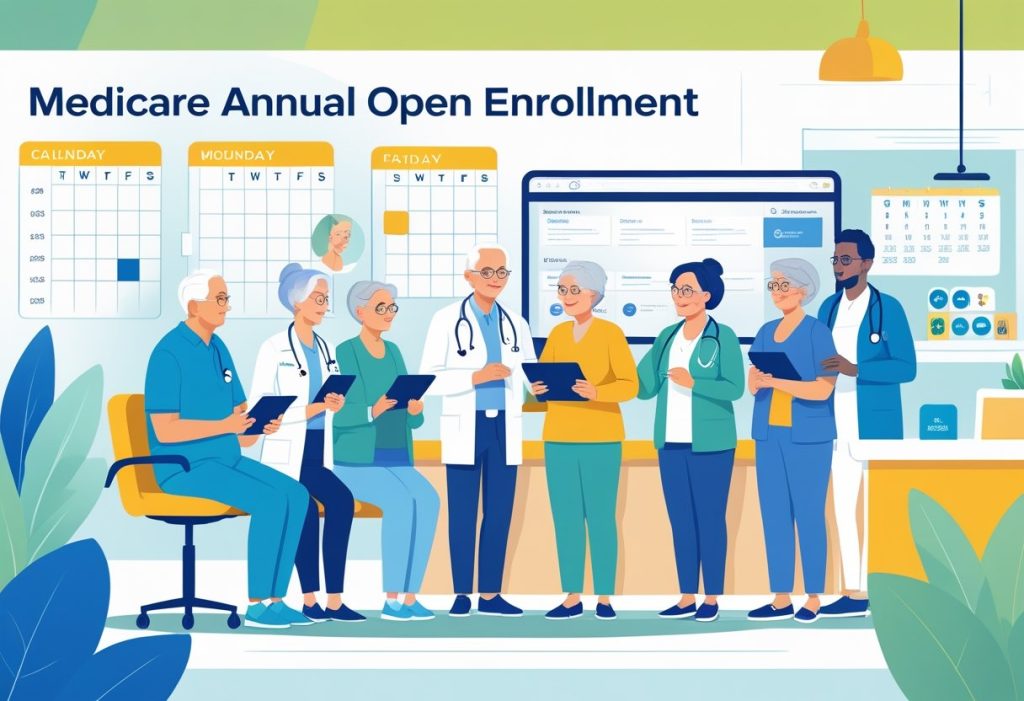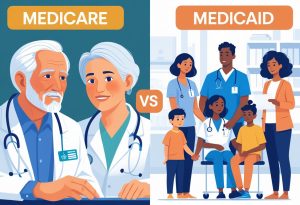The Medicare Annual Open Enrollment Period is a crucial time for beneficiaries to review their healthcare coverage and make necessary changes. This period allows you to switch plans, add or drop coverage, and ensure that your healthcare needs are met for the coming year. You have the chance to evaluate various options, from traditional Medicare to Medicare Advantage plans, making sure you choose what works best for you.
Understanding the nuances of the enrollment process can empower you to make informed decisions. At The Modern Medicare Agency, our licensed agents provide personalized assistance to identify plans that align with your needs and budget. You can have real conversations with professionals who understand the intricacies of Medicare, ensuring you find coverage without the burden of hidden fees.
Don’t miss this opportunity to secure the best Medicare plan for your health and financial well-being. Each year, changes in coverage options and costs can impact your healthcare experience, making it essential to actively participate in this enrollment period.
Understanding Medicare Annual Open Enrollment
During the Medicare Annual Open Enrollment Period (AEP), beneficiaries have the opportunity to evaluate and adjust their health coverage options. This critical period enables you to make informed decisions regarding your Medicare plans, ensuring you receive the benefits that suit your needs.
What Is the Medicare Annual Enrollment Period?
The Medicare Annual Enrollment Period (AEP) is the designated time when Medicare beneficiaries can make changes to their health coverage. During this period, you can enroll in a new Medicare Advantage plan, switch from Original Medicare to a Medicare Advantage plan, or make changes to your existing plan. This allows for adjustments based on personal health needs or changes in available plans. Coverage selected during AEP typically begins on January 1 of the following year.
Eligibility for Medicare Open Enrollment
To be eligible for Medicare Open Enrollment, you must be enrolled in Medicare. Generally, this includes individuals aged 65 or older or younger individuals with certain disabilities. If you’re already part of a Medicare plan, AEP allows you to review and adjust your options without penalty. It’s crucial to understand that eligibility strictly applies to those already enrolled in Medicare and does not grant new enrollment opportunities for those not yet eligible.
Key Dates for Medicare Open Enrollment
The Medicare Open Enrollment Period occurs annually from October 15 to December 7. During this timeframe, you can evaluate your coverage options and make necessary changes. Important dates include:
- October 15: Start of AEP
- December 7: End of AEP
Changes made during this period will take effect on January 1 of the following year. Staying aware of these dates is essential to ensure you don’t miss the opportunity to switch or enroll. Using resources like Medicare.gov can help you track your enrollment and options effectively.
For personalized guidance through the Medicare Open Enrollment process, consider working with The Modern Medicare Agency. Our licensed agents provide one-on-one consultations to help you navigate Medicare plans without any hidden fees.
Medicare Coverage Options During Open Enrollment
During the Medicare Open Enrollment period, it’s essential to understand the various coverage options available. These include Original Medicare, Medicare Advantage, Prescription Drug Coverage, and Medicare Supplement Insurance. Each option offers different benefits, costs, and flexibility.
Original Medicare: Part A and Part B
Original Medicare consists of two main parts: Part A and Part B. Part A covers hospital stays, skilled nursing facilities, hospice care, and some home health services. Most people qualify for premium-free Part A if they or their spouse paid Medicare taxes for a certain period.
Part B, on the other hand, covers outpatient services, including doctor visits, preventive care, and necessary medical equipment. There is a monthly premium for Part B, which varies based on income. Understanding your liability for coinsurance and deductibles under Original Medicare is crucial. This option provides flexibility in choosing providers, as you can see any doctor or specialist who accepts Medicare.
Medicare Advantage Plans (Part C)
Medicare Advantage plans, or Part C, are offered by private insurers approved by Medicare. These plans bundle benefits from both Part A and Part B and often include additional features such as vision and dental coverage.
Many Medicare Advantage plans also include a Prescription Drug Plan (PDP). You can choose between Health Maintenance Organization (HMO) or Preferred Provider Organization (PPO) models based on your preference for flexibility versus cost. However, these plans typically require you to use a network of providers, which may affect your choice of doctors.
Prescription Drug Coverage: Part D Plans
Medicare Part D provides prescription drug coverage, helping to offset costs for medications. You can enroll in a stand-alone Part D prescription drug plan if you are on Original Medicare or choose a Medicare Advantage plan that includes drug coverage.
Part D plans vary in terms of premiums, formularies, and copayments. It’s essential to review your medications and ensure that they are covered. You may also consider the Model Medicare Agency for personalized assistance in aligning your prescription needs with the best plan options.
Medicare Supplement Insurance (Medigap)
Medicare Supplement Insurance, or Medigap, is designed to help cover out-of-pocket costs not paid by Original Medicare. This includes copayments, coinsurance, and deductibles.
Medigap plans are standardized, meaning the benefits offered are the same regardless of the insurer. You can select from different plans designated by letters (A, B, C, etc.), each offering varying levels of coverage. It’s essential to purchase a Medigap plan within the six-month Medigap Open Enrollment period, ensuring you have guaranteed issue rights. Consider partnering with The Modern Medicare Agency to identify the right Medigap plan that fits your financial situation. Our licensed agents provide personalized assistance to navigate these options effectively.
Enrollment Processes and Important Periods
Navigating Medicare’s enrollment processes can be essential for your healthcare planning. Understanding the various enrollment periods ensures you select the best coverage options for your needs.
Medicare Initial Enrollment Period
The Medicare Initial Enrollment Period (IEP) is a crucial window for new beneficiaries. It lasts seven months: three months before, the month of, and three months after you turn 65. If you’re eligible due to a disability, your IEP begins 24 months after you receive Social Security Disability Insurance.
During this time, you can enroll in Original Medicare (Part A and Part B). If you miss this period, you may face late enrollment penalties, which could increase your premiums. It’s essential to act within this window to avoid higher costs later.
Special Enrollment Periods
Medicare Special Enrollment Periods (SEPs) allow you to enroll outside the usual timeframe under specific circumstances. Common triggers for SEPs include moving out of your plan’s service area, losing other health coverage, or experiencing certain life events, like retirement.
SEPs typically last for two months after the event occurs. In some cases, such as moving, they can extend longer. You should review your options promptly during this time to ensure continuous healthcare coverage without penalties.
General Enrollment Period
The General Enrollment Period (GEP) occurs annually from January 1 to March 31. It is intended for those who did not sign up for Medicare during their IEP or who delayed enrollment.
During this period, you can enroll in Part A (if you pay premiums) and Part B. Remember that enrolling during the GEP may result in a late enrollment penalty, which adds 10% to your premium for each 12-month period you were eligible but did not enroll. Coverage starts on July 1 of that year.
Medicare Advantage Open Enrollment Period
The Medicare Advantage Open Enrollment Period (MAOEP) runs from January 1 to March 31 each year. During this window, beneficiaries with a Medicare Advantage plan can switch to another Medicare Advantage plan or return to Original Medicare.
You may also enroll in a standalone Part D plan during this time. The MAOEP differs from the annual open enrollment period, as it specifically caters to those already enrolled in Medicare Advantage. It’s an excellent opportunity to reassess your current plan and ensure it aligns with your healthcare needs.
Choosing the right Medicare options can be complex. Working with The Modern Medicare Agency gives you access to licensed agents who provide personalized assistance. Our agents help identify Medicare packages that fit your requirements, ensuring you receive quality advice without extra fees.
Making Changes to Your Medicare Plan
During the Medicare Annual Open Enrollment Period, you can make important adjustments to your Medicare coverage. This includes switching plans or modifying your prescription drug coverage. Understanding your options is crucial for optimal healthcare management.
Switching Between Plans
You have the opportunity to change your Medicare Advantage plan or Original Medicare during the enrollment window, which occurs each year from October 15 to December 7.
When switching plans, consider the following:
- Monthly premiums: Compare costs between plans.
- Out-of-pocket costs: Review deductibles and co-pays.
- Coverage network: Ensure your preferred doctors and hospitals are included.
- Formulary: Check that your prescription drugs are covered.
Make sure to evaluate the Annual Notice of Change from your current provider, which outlines any significant changes in your coverage, costs, or formulary. This information will help you align your healthcare needs effectively.
Adding or Dropping Prescription Drug Coverage
Modifying your prescription drug coverage is another critical aspect of your Medicare plan. If you’re enrolled in a Medicare Advantage plan, it often includes drug coverage. You may want to add or switch to a standalone Medicare Part D plan if it better meets your needs.
Key points to evaluate:
- Creditable prescription drug coverage: Determine if your current plan offers this, as it affects your late enrollment penalties.
- Plan formularies: Compare the drugs covered by different plans.
- Costs: Evaluate monthly premiums, deductibles, and co-pays.
Always consult with a licensed agent from The Modern Medicare Agency for tailored advice. They can provide personalized assistance without extra fees, ensuring you find the right fit for your Medicare insurance needs.
Factors to Consider During Medicare Annual Enrollment
When navigating the Medicare Annual Enrollment Period, understanding key factors can lead to better healthcare choices. Particular attention should be paid to plan benefits, costs, and individual healthcare needs, allowing you to optimize your coverage.
Comparing Plan Benefits and Costs
It’s essential to evaluate the benefits each plan offers, including coverage for hearing exams, vision care, and prescription medications. Review premiums and out-of-pocket costs, as these directly affect your budgeting. Check for additional benefits like telehealth services or wellness programs.
To make informed choices, create a comparison chart. This can list:
- Premiums
- Deductibles
- Co-payments
By assessing these financial elements, you can choose a plan that provides comprehensive coverage without excessive costs. Consider potential savings through programs such as the low-income subsidy, which helps offset premiums.
Star Ratings and Plan Performance
Medicare evaluates plans based on performance, reflected in star ratings. Plans can receive ratings from 1 to 5 stars, with higher numbers indicating better quality. When considering a plan, check these ratings to gauge aspects like customer service, paperwork accuracy, and care quality.
A plan with consistently high ratings may offer superior access to doctors and efficient management of services, helping you avoid issues like prior authorization and step therapy. Keep in mind, a higher star rating often corresponds to better overall value and satisfaction, aligning with your healthcare expectations.
Assessing Healthcare Needs
Your specific healthcare needs should drive decisions during enrollment. Consider any ongoing treatments, medications, and anticipated medical services. If you have chronic conditions, look for plans that cover specialized care and have adequate provider networks.
Account for lifestyle factors such as frequency of doctor visits, and think about how inflation may impact medical costs. Be cautious of the late enrollment penalty for delaying enrollment. If you did not enroll when first eligible, assess how your choices today could impact your financial future.
For personalized guidance, consult with agents at The Modern Medicare Agency, where you can receive tailored advice without hidden fees.
Frequently Asked Questions
Navigating the Medicare Annual Open Enrollment period can raise various questions. Here are key details about enrollment dates, changes you can make to your coverage, eligibility requirements, and more.
When does the Medicare Annual Open Enrollment period begin and end?
The Medicare Annual Open Enrollment period takes place from October 15 to December 7 each year. During this time, you have the opportunity to review and change your Medicare plans.
What changes can I make to my Medicare coverage during the Annual Open Enrollment period?
You can switch from Original Medicare to a Medicare Advantage plan or vice versa. Additionally, you may change your Medicare Advantage or Part D prescription drug plan, allowing you to select plans that better meet your needs.
Are there any specific eligibility requirements for participating in the Medicare Annual Open Enrollment?
To participate, you must be enrolled in Medicare. You can make changes regardless of your initial enrollment date, provided you are within the designated open enrollment period.
Can I enroll in a Medicare Advantage plan during the Annual Open Enrollment?
Yes, during this period, you can enroll in a Medicare Advantage plan or make changes to an existing plan. This option enables you to select coverage that best fits your health needs.
What is the difference between the Annual Open Enrollment Period and the Medicare Advantage Open Enrollment Period?
The Annual Open Enrollment Period allows all Medicare beneficiaries to make changes to their plans. In contrast, the Medicare Advantage Open Enrollment Period, which runs from January 1 to March 31, is limited to individuals already enrolled in a Medicare Advantage plan who want to make changes.
What happens if I miss the Annual Open Enrollment deadline?
If you miss the deadline, you generally cannot make changes to your Medicare coverage until the next enrollment period. However, special circumstances may allow you to change your plans outside of the open enrollment window.
For tailored assistance, consider working with The Modern Medicare Agency. Our licensed agents provide personalized support, helping you find Medicare packages that fit your specifications without hidden fees.






